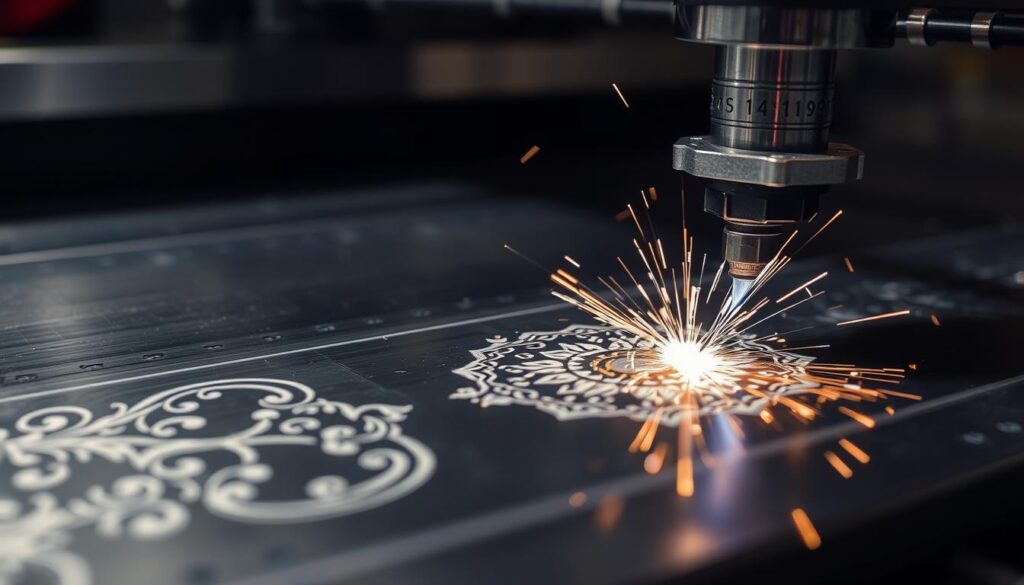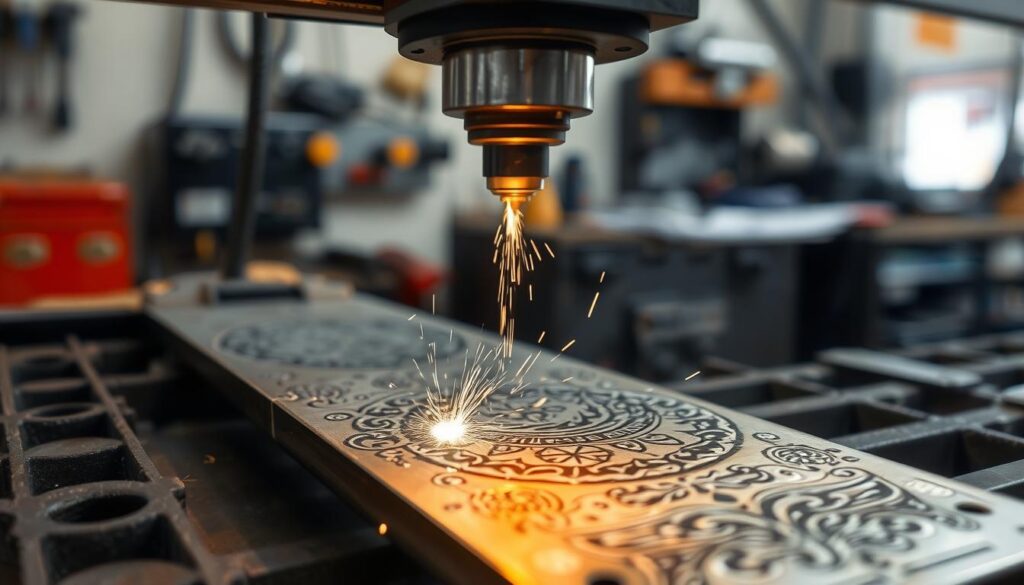Laser engraving on iron is a precise process. It uses a high-intensity laser beam to remove material from a solid surface. The time it takes to engrave can be adjusted for better results, whether you want it fast or precise.
Several factors affect the engraving time. These include laser power, speed, frequency, pulse duration, focus, and the number of passes. Each one plays a role in how long it takes to engrave.
When choosing settings, you can focus on speed or quality. Fast settings get the job done quicker, while quality settings focus on precision and finish. Finding the right balance is key to great results.
This article will dive into the techniques and considerations for controlling engraving time on iron. We’ll make sure the final results are both efficient and of high quality.
Understanding Time-Optimized vs Quality-Optimized Engraving Parameters
In iron surface engraving, laser experts must find a balance between speed and quality. Trotec laser software offers 50 material sets with two options: time-optimized and quality-optimized. The right choice depends on the project’s needs.
Speed and Power Settings for Time Efficiency
Time-optimized settings aim for quick engraving depth, even if quality is slightly lower. For example, to engrave 200 μm on stainless steel, use 100% power, 250 mm/s speed, 60 kHz frequency, and 200 ns pulse duration.
Quality Parameters for Precision Results
Quality-optimized settings focus on precision, leading to better engraving quality. This might include 100% power, 900 mm/s speed, 180 kHz frequency, and 200 ns pulse duration. It takes longer but results in cleaner, less distorted engravings.
Balancing Speed and Quality in Production
When using metal marking solutions and precision laser engravers, balancing speed and quality is key. Adjusting laser settings based on project needs and desired outcomes is crucial. Start with low power and high speeds for new materials to avoid damage to the iron surface.
The choice between time-optimized and quality-optimized settings depends on the project’s priorities. It’s about finding the right balance for the desired level of detail and precision in the iron surface engraving.
Essential Factors Affecting Iron Engraving Duration
When we talk about laser marking on iron, several key factors come into play. The metal’s type and thickness, the engraving depth, and the laser’s power all affect the time needed. These elements are crucial for the engraving process.
Harder metals, like stainless steel, need more laser power for good results. This means longer engraving times. Softer metals, like aluminum, require less power and engraving is faster. Thicker metals and deeper engravings also take more time and power to vaporize the material.
The laser type, whether CO2 or fiber, also impacts engraving time and quality. Fiber lasers are more efficient for metal engraving because they emit shorter wavelengths. CO2 lasers, which operate in the red and infrared spectrum, are less efficient.
Knowing these factors is key to improving the iron product personalization process. By considering metal type, thickness, and laser power, manufacturers can make their customized iron engraving faster and of higher quality.
| Laser Type | Wavelength | Suitability for Metal Engraving | Engraving Duration |
|---|---|---|---|
| Fiber Laser | Blue, Violet, Ultraviolet | Highly Suitable | Faster |
| CO2 Laser | Red, Infrared | Less Suitable | Slower |
| Diode Laser | 1,064 nm | Suitable, but with Lower Power and Precision | Moderate |

Laser Engraving on Iron: Technical Parameters and Setup
To get the best results in laser engraving on iron, you need to tweak some settings. The frequency is key, ranging from 60 kHz for fast engraving to 180 kHz for better quality. The pulse duration is always 200 ns, no matter the method.
Keeping the focus distance the same is vital for even results. The filling line distance should be 0.03 mm. Using a bidirectional approach helps cover the area well.
Optimal Frequency and Pulse Duration Settings
The frequency for laser engraving on iron can be adjusted for speed or quality. For quick work, use 60 kHz. For better quality, go for 180 kHz. The pulse duration is always 200 ns for the best results.
Focus Distance and Line Spacing Considerations
Having a consistent focus distance is key for precise iron engraving. Keep the focus distance the same for all engraving. The filling line distance is 0.03 mm, and a bidirectional approach ensures full coverage.
Number of Passes for Desired Depth
The depth you want affects how many passes you need. For a 200 μm depth, about 32 passes are needed for fast engraving. For quality, up to 450 passes might be required for the best detail.

By adjusting these technical settings, laser engraving on iron can produce consistent, high-quality results. These results are perfect for various uses, from industrial to artistic and decorative.
Advanced Techniques for Controlling Metal Surface Quality
In the world of industrial laser engraving, advanced techniques are key to keeping metal surfaces perfect. Dynamic focusing systems adjust the laser beam’s focus for even engraving depth. This is especially useful for iron surface engraving, where quality matters most.
MOPA lasers are another game-changer for metal marking. They let you control the laser’s pulse for clear, detailed marks. This is great for metal marking solutions that need to look their best.
For better production and quality, use batch processing and remote monitoring. These tools help keep quality high and work more efficiently. This means better results for customers.
Using these advanced methods, metal engraving experts can always get the best results. They meet their clients’ high standards in many industrial applications. The mix of dynamic focusing, MOPA lasers, and automation makes every project precise and efficient.
Optimizing Engraving Depth and Material Removal
To get the right depth in iron laser etching or customized iron engraving, you need to adjust settings carefully. Whether you want to save time or focus on quality, your choice affects the outcome.
Deep Engraving Parameters for Iron
For a deep engraving of 200 μm on iron, use quality-optimized settings. This means 100% laser power, 900 mm/s speed, and 450 passes. It ensures a top-notch finish, with engraving depth between 200 μm and 220 μm.
For a quicker approach, time-optimized settings can engrave 200 μm in just 112 seconds. A 20-watt MOPA laser with an F-160 lens is used. But, this might cause a warp of up to 100 μm and a depth range of 200 μm to 240 μm.
Surface Preparation Methods
Getting the surface right is key for quality results with a metal engraving machine on iron. Clean the surface to remove dirt or apply special coatings to improve engraving.
Post-Processing Considerations
After engraving, you might need to clean up, apply protective coatings, or polish. This step is important to make the customized iron engraving look its best.
Choosing between time-saving and quality-focused approaches for iron laser etching or customized iron engraving is crucial. Think about the parameters, surface prep, and post-processing to get the best results.
Industrial Applications and Production Efficiency
Industrial laser marking has changed the game for iron products and metal solutions. Fiber lasers stand out for their speed, precision, and long life. They are perfect for making lots of products quickly.
Industrial laser engraving on iron can make detailed barcodes, serial numbers, logos, and designs. It works with popular software and remote monitoring. This makes production faster and more efficient.
Being able to engrave many parts at once saves a lot of time. It also cuts down on downtime with predictive maintenance. This keeps production running smoothly and efficiently.
| Feature | Benefit |
|---|---|
| High-speed fiber laser technology | Faster production, increased efficiency |
| Precision engraving capabilities | Detailed, high-quality markings on iron products |
| Batch processing capabilities | Reduced production time, higher throughput |
| Predictive maintenance features | Minimized downtime, maximized productivity |
Using industrial laser marking, manufacturers can make their iron products better and faster. This helps them grow and make more money in their industries.
Conclusion
Laser engraving on iron needs a careful mix of speed and precision for the best results. The type of metal, its thickness, the desired depth, and the surface quality are all important. Adjusting the laser settings like power, frequency, and pulse duration is key to controlling the engraving.
Advanced methods and tools, like MOPA lasers and dynamic focusing systems, improve control and precision. They are used for custom iron engraving in many fields. This includes making special equipment, personalized gifts, and marking metal parts with serial numbers and QR codes.
The need for precise laser engraving on iron and other metals is rising. The industry is changing, with new solutions for its challenges. By knowing the technical details and using the latest tech, experts can get the most out of laser engraving. They can create high-quality, lasting results that meet their specific needs.

Leave a Reply